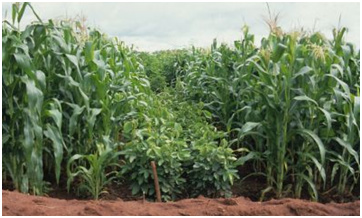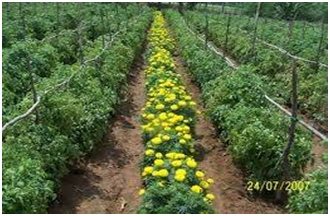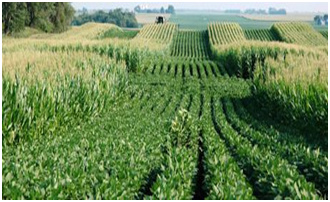INTER CROPPING AND ITS ADVANTAGES
Intercropping is a practice involving growing two or more crops simultaneously on a same piece of land. The main advantage of inter cropping is getting higher returns from the same piece of land which otherwise not be utilized by a single crop.
Inter cropping needs a careful planning wherein the soil, water, climate, light etc are taken into account. While planning inter cropping it is important to select the crops which do not compete with each other for space, nutrient, water or sunlight. It is advisable to grow crops like shallow rooted crops with deep rooted crops, tall crop with a short plant, shade loving plant with light requiring plants, early maturing crop with late maturing crops etc. Such planning will ensure the added yield advantage for the farmers from multiple crops.
Inter cropping also helps in providing mutual benefits to the crops. For example, growing legumes along with cereals, vegetables will fix atmospheric nitrogen in soil and thereby improving the nitrogen uptake to the adjoining plants.
Growing light sensitive plants along with the tall plants gives a shade which otherwise was wasted. For Example, in the multi tier cropping system,the tall plants like Coconut, arecanut occupy the top tier followed by banana, bhendi which occupy middle tier and short plants like pineapple, ginger, legumes, beetroot etc occupy the lower canopy/tier which will ensure good crop canopy and higher returns from multiple crop sources.
Inter cropping also provide good biodiversity by providing a habitat for variety of insects, soil organisms etc which provide nitrogen fixation and fixing other valuable nutrients in soil which will be lacking in single crop environment.
The other main advantage of intercropping is pest management. Following good intercropping practices reduces the crop pest outbreaks by increasing the predator biodiversity. Also avoiding mono cropping will control and manage the biological dispersal of pest organisms through the crop.
Inter cropping also acts as crop insurance during crop failure due to unforeseen weather conditions. It also acts as a soil conservator and minimizes the weed growth due to good canopy cover. It will also ensure better utilization of nutrients and fertilizers which otherwise be wasted through runoff and leaching. Crops can also be grown in alternate strips running perpendicular to the slope of the land thereby conserving soil from erosion and depletion.
The main disadvantage in intercropping is yield variation due to different competitive abilities of crops. Also inter cultivation activities will be difficult to conduct due to crop density. Harvesting will be difficult.
With the minimal disadvantage, Inter cropping is beneficial to the farmers if managed with proper planning and guidance to get extra source of income.



